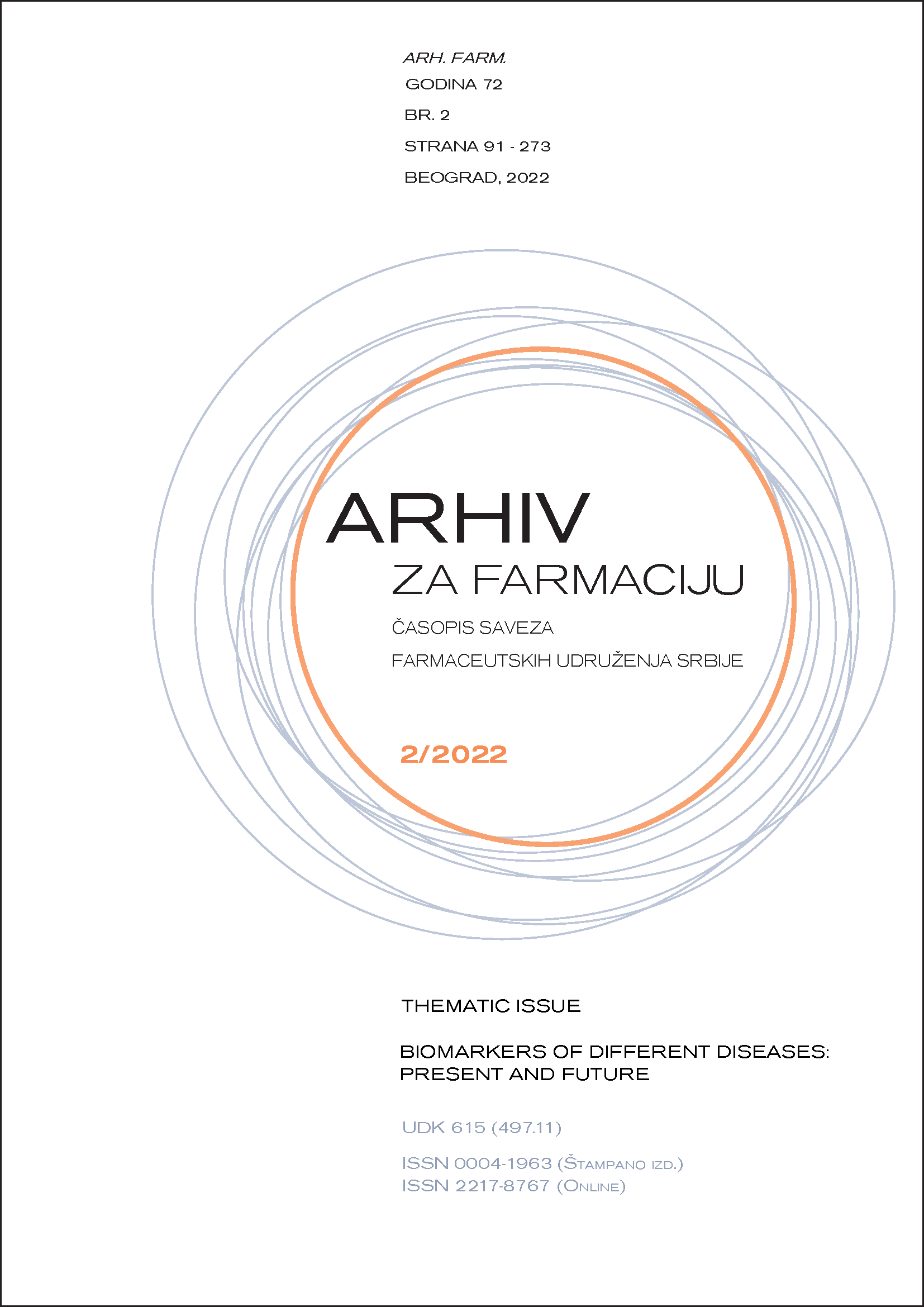Current challenges in laboratory diagnostics of autonomous cortisol secretion in adrenal incidentalomas
Diagnosis of autonomous cortisol secretion
Abstract
Adrenal incidentalomas are unexpectedly identified adrenal masses without prior suspicion of the existence of adrenal disease. The majority of adrenal incidentalomas are benign adrenal adenomas (80–90%), and they are non-functioning adrenocortical adenomas in more than 70% of cases. Mild hypercortisolemia is the most common finding in hormonally active adrenal incidentalomas. It is defined as autonomous cortisol secretion in up to 15% of patients. Despite a lot of research that anticipated higher cardiometabolic risk in patients with autonomous cortisol secretion, there is still no clear consensus on biochemical criteria for an autonomous cortisol secretion diagnosis in patients with adrenal incidentalomas. This review delineates the advantages and limitations of different laboratory tests recommended for the diagnosis of autonomous cortisol secretion in adrenal incidentalomas.
References
Chatzellis E, Kaltsas G. Adrenal Incidentalomas. [Updated 2019 Nov 7]. In: Feingold KR, Anawalt B, Boyce A, Chrousos G, de Herder WW, Dhatariya K, et al., editors. Endotext [Internet]. South Dartmouth (MA): MDText.com, Inc.; 2000–Available from: https://www.ncbi.nlm.nih.gov/books/NBK279021/
Terzolo M, Stigliano A, Chiodini I, Loli P, Furlani L, Arnaldi G, et al. Italian Association of Clinical Endocrinologists. AME position statement on adrenal incidentaloma. Eur J Endocrinol. 2011;164(6):851-70.
Kloos RT, Gross MD, Francis IR, Korobkin M, Shapiro B. Incidentally discovered adrenal masses. Endocr Rev. 1995;16(4):460-84.
Fassnacht M, Arlt W, Bancos I, Dralle H, Newell-Price J, Sahdev A, et al. Management of adrenal incidentalomas: European Society of Endocrinology Clinical Practice Guideline in collaboration with the European Network for the Study of Adrenal Tumors. Eur J Endocrinol. 2016;175(2):G1-G34.
Mehdi A, Rao P, Thomas G. Our evolving understanding of primary aldosteronism. Cleve Clin J Med. 2021;88(4):221-7.
Ueland GÅ, Grinde T, Methlie P, Kelp O, Løvås K, Husebye ES. Diagnostic testing of autonomous cortisol secretion in adrenal incidentalomas. Endocr Connect. 2020;9(10):963-70.
Di Dalmazi G, Vicennati V, Garelli S, Casadio E, Rinaldi E, Giampalma E, et al. Cardiovascular events and mortality in patients with adrenal incidentalomas that are either non-secreting or associated with intermediate phenotype or subclinical Cushing’s syndrome: a 15-year retrospective study. Lancet Diabetes Endocrinol. 2014;2(5):396-405.
Debono M, Bradburn M, Bull M, Harrison B, Ross RJ, Newell-Price J. Cortisol as a marker for increased mortality in patients with incidental adrenocortical adenomas. J Clin Endocrinol Metab. 2014;99(12):4462-70.
Chiodini I, Vainicher CE, Morelli V, Palmieri S, Cairoli E, Salcuni AS, et al. Mechanisms in endocrinology: Endogenous subclinical hypercortisolism and bone: a clinical review. Eur J Endocrinol. 2016;175(6):R265-R282.
Nieman L. Chapter 5 - Making the Diagnosis: Laboratory Testing and Imaging Studies. In: Laws ER, editor. Cushing’s Disease. United States; Endocrinology Consultation Service, National Institutes of Health, Bethesda, MD, United States: Academic Press, 2017; p. 75-90.
Chiodini I. Diagnosis and Treatment of Subclinical Hypercortisolism. J Clin Endocrinol Metab. 2011;96:1223-36.
Yanase T, Oki Y, Katabami T, Otsuki M, Kageyama K, Tanaka T, et al. New diagnostic criteria of adrenal subclinical Cushing’s syndrome: opinion from the Japan Endocrine Society. Endocr J. 2018;65(4):383-93.
Araujo-Castro M, Sampedro Núñez MA, Marazuela M. Autonomous cortisol secretion in adrenal incidentalomas. Endocrine. 2019;64(1):1-13.
Pecori Giraldi F, Ambrogio AG. Variability in laboratory parameters used for management of Cushing’s syndrome. Endocrine. 2015;50(3):580-9.
Rosano TG, Demers LM, Hillam R, Dybas MT, Leinung M. Clinical and analytical evaluation of an immunoradiometric assay for corticotropin. Clin Chem. 1995;41(7):1022-7.
Coste J, Strauch G, Letrait M, Bertagna X. Reliability of hormonal levels for assessing the hypothalamic-pituitary-adrenocortical system in clinical pharmacology. Br J Clin Pharmacol. 1994;38(5):474-9.
Nieman LK, Biller BMK, Findling JW, Newell-Price J, Savage MO, Stewart PM, et al. The Diagnosis of Cushing’s Syndrome: An Endocrine Society Clinical Practice Guideline. J Clin Endocrinol Metab. 2008;93(5):1526-40.
Raff H, Raff JL, Findling JW. Late-Night Salivary Cortisol as a Screening Test for Cushing’s Syndrome. J Clin Endocrinol Metab. 1998;83(8):2681-6.
Newell-Price J, Trainer P, Perry L, Wass J, Grossman A, Besser M. A single sleeping midnight cortisol has 100% sensitivity for the diagnosis of Cushing’s syndrome. Clin Endocrinol (Oxf). 1995;43(5):545-50.
Fischli S, Jenni S, Allemann S, Zwahlen M, Diem P, Christ ER, et al. Dehydroepiandrosterone sulfate in the assessment of the hypothalamic-pituitary-adrenal axis. J Clin Endocrinol Metab. 2008;93(2):539-42.
Labrie F, Luu-The V, Martel C, Chernomoretz A, Calvo E, Morissette J, et al. Dehydroepiandrosterone (DHEA) is an anabolic steroid like dihydrotestosterone (DHT), the most potent natural androgen, and tetrahydrogestrinone (THG). J Steroid Biochem Mol Biol. 2006;100(1-3):52-8.
Phillips AC, Carroll D, Gale CR, Lord JM, Arlt W, Batty GD. Cortisol, DHEA sulphate, their ratio, and all-cause and cause-specific mortality in the Vietnam Experience Study. Eur J Endocrinol. 2010;163(2):285-92.
Dennedy MC, Annamalai AK, Prankerd-Smith O, Freeman N, Vengopal K, Graggaber J, et al. Low DHEAS: A Sensitive and Specific Test for the Detection of Subclinical Hypercortisolism in Adrenal Incidentalomas. J Clin Endocrinol Metab. 2017;102(3):786-92.
Akehi Y, Kawate H, Murase K, Nagaishi R, Nomiyama T, Nomura M, et al. Proposed diagnostic criteria for subclinical Cushing's syndrome associated with adrenal incidentaloma. Endocr J. 2013;60(7):903-12.
Bencsik Z, Szabolcs I, Kovács Z, Ferencz A, Vörös A, Kaszás I, et al. Low dehydroepiandrosterone sulfate (DHEA-S) level is not a good predictor of hormonal activity in nonselected patients with incidentally detected adrenal tumors. J Clin Endocrinol Metab. 1996;81(5):1726-9.

